Haoyu Han
Enhancing LLM-Based Short Answer Grading with Retrieval-Augmented Generation
Apr 07, 2025



Abstract:Short answer assessment is a vital component of science education, allowing evaluation of students' complex three-dimensional understanding. Large language models (LLMs) that possess human-like ability in linguistic tasks are increasingly popular in assisting human graders to reduce their workload. However, LLMs' limitations in domain knowledge restrict their understanding in task-specific requirements and hinder their ability to achieve satisfactory performance. Retrieval-augmented generation (RAG) emerges as a promising solution by enabling LLMs to access relevant domain-specific knowledge during assessment. In this work, we propose an adaptive RAG framework for automated grading that dynamically retrieves and incorporates domain-specific knowledge based on the question and student answer context. Our approach combines semantic search and curated educational sources to retrieve valuable reference materials. Experimental results in a science education dataset demonstrate that our system achieves an improvement in grading accuracy compared to baseline LLM approaches. The findings suggest that RAG-enhanced grading systems can serve as reliable support with efficient performance gains.
Language Guided Concept Bottleneck Models for Interpretable Continual Learning
Mar 30, 2025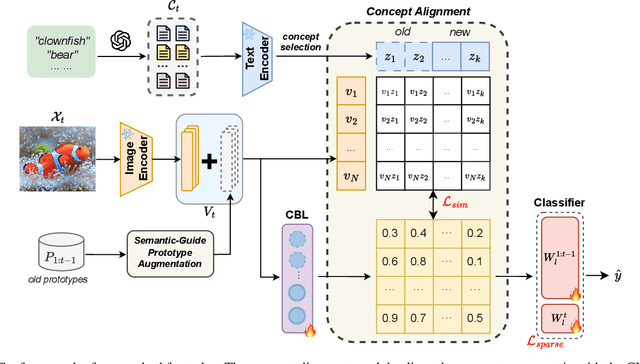


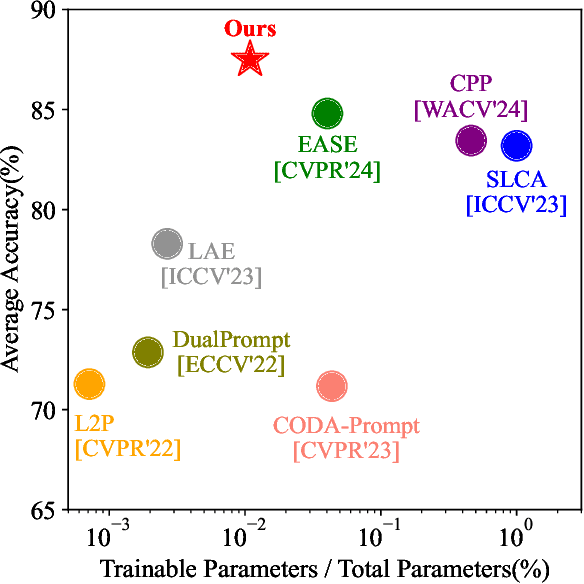
Abstract:Continual learning (CL) aims to enable learning systems to acquire new knowledge constantly without forgetting previously learned information. CL faces the challenge of mitigating catastrophic forgetting while maintaining interpretability across tasks. Most existing CL methods focus primarily on preserving learned knowledge to improve model performance. However, as new information is introduced, the interpretability of the learning process becomes crucial for understanding the evolving decision-making process, yet it is rarely explored. In this paper, we introduce a novel framework that integrates language-guided Concept Bottleneck Models (CBMs) to address both challenges. Our approach leverages the Concept Bottleneck Layer, aligning semantic consistency with CLIP models to learn human-understandable concepts that can generalize across tasks. By focusing on interpretable concepts, our method not only enhances the models ability to retain knowledge over time but also provides transparent decision-making insights. We demonstrate the effectiveness of our approach by achieving superior performance on several datasets, outperforming state-of-the-art methods with an improvement of up to 3.06% in final average accuracy on ImageNet-subset. Additionally, we offer concept visualizations for model predictions, further advancing the understanding of interpretable continual learning.
Empowering GraphRAG with Knowledge Filtering and Integration
Mar 18, 2025Abstract:In recent years, large language models (LLMs) have revolutionized the field of natural language processing. However, they often suffer from knowledge gaps and hallucinations. Graph retrieval-augmented generation (GraphRAG) enhances LLM reasoning by integrating structured knowledge from external graphs. However, we identify two key challenges that plague GraphRAG:(1) Retrieving noisy and irrelevant information can degrade performance and (2)Excessive reliance on external knowledge suppresses the model's intrinsic reasoning. To address these issues, we propose GraphRAG-FI (Filtering and Integration), consisting of GraphRAG-Filtering and GraphRAG-Integration. GraphRAG-Filtering employs a two-stage filtering mechanism to refine retrieved information. GraphRAG-Integration employs a logits-based selection strategy to balance external knowledge from GraphRAG with the LLM's intrinsic reasoning,reducing over-reliance on retrievals. Experiments on knowledge graph QA tasks demonstrate that GraphRAG-FI significantly improves reasoning performance across multiple backbone models, establishing a more reliable and effective GraphRAG framework.
Mixture of Structural-and-Textual Retrieval over Text-rich Graph Knowledge Bases
Feb 27, 2025Abstract:Text-rich Graph Knowledge Bases (TG-KBs) have become increasingly crucial for answering queries by providing textual and structural knowledge. However, current retrieval methods often retrieve these two types of knowledge in isolation without considering their mutual reinforcement and some hybrid methods even bypass structural retrieval entirely after neighboring aggregation. To fill in this gap, we propose a Mixture of Structural-and-Textual Retrieval (MoR) to retrieve these two types of knowledge via a Planning-Reasoning-Organizing framework. In the Planning stage, MoR generates textual planning graphs delineating the logic for answering queries. Following planning graphs, in the Reasoning stage, MoR interweaves structural traversal and textual matching to obtain candidates from TG-KBs. In the Organizing stage, MoR further reranks fetched candidates based on their structural trajectory. Extensive experiments demonstrate the superiority of MoR in harmonizing structural and textual retrieval with insights, including uneven retrieving performance across different query logics and the benefits of integrating structural trajectories for candidate reranking. Our code is available at https://github.com/Yoega/MoR.
Unveiling Mode Connectivity in Graph Neural Networks
Feb 18, 2025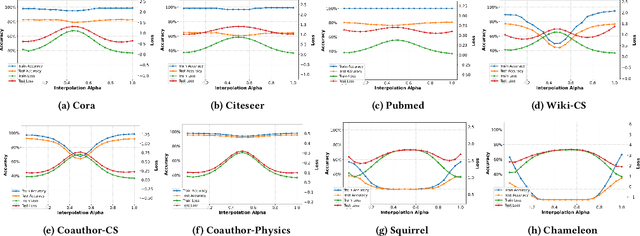
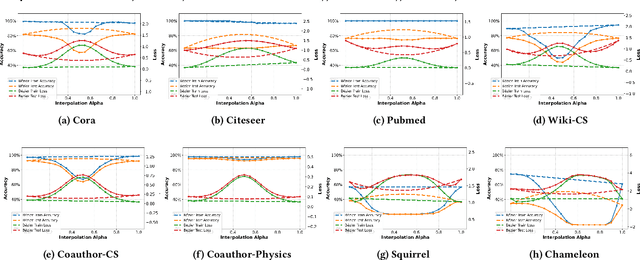
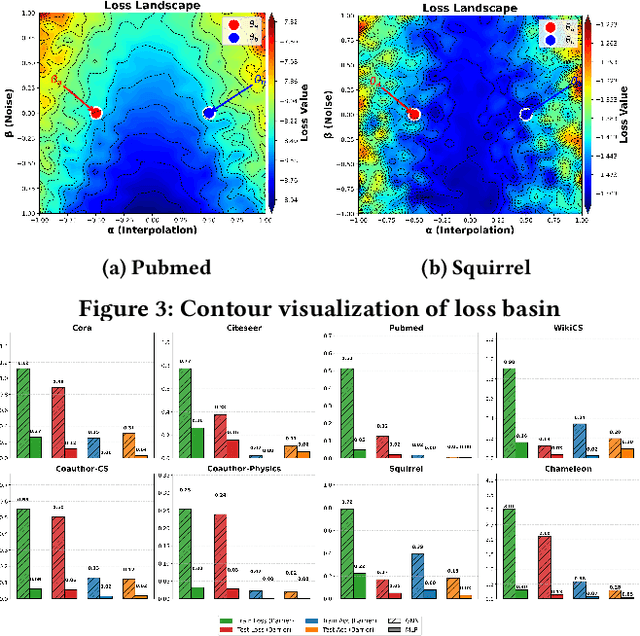

Abstract:A fundamental challenge in understanding graph neural networks (GNNs) lies in characterizing their optimization dynamics and loss landscape geometry, critical for improving interpretability and robustness. While mode connectivity, a lens for analyzing geometric properties of loss landscapes has proven insightful for other deep learning architectures, its implications for GNNs remain unexplored. This work presents the first investigation of mode connectivity in GNNs. We uncover that GNNs exhibit distinct non-linear mode connectivity, diverging from patterns observed in fully-connected networks or CNNs. Crucially, we demonstrate that graph structure, rather than model architecture, dominates this behavior, with graph properties like homophily correlating with mode connectivity patterns. We further establish a link between mode connectivity and generalization, proposing a generalization bound based on loss barriers and revealing its utility as a diagnostic tool. Our findings further bridge theoretical insights with practical implications: they rationalize domain alignment strategies in graph learning and provide a foundation for refining GNN training paradigms.
RAG vs. GraphRAG: A Systematic Evaluation and Key Insights
Feb 17, 2025Abstract:Retrieval-Augmented Generation (RAG) enhances the performance of LLMs across various tasks by retrieving relevant information from external sources, particularly on text-based data. For structured data, such as knowledge graphs, GraphRAG has been widely used to retrieve relevant information. However, recent studies have revealed that structuring implicit knowledge from text into graphs can benefit certain tasks, extending the application of GraphRAG from graph data to general text-based data. Despite their successful extensions, most applications of GraphRAG for text data have been designed for specific tasks and datasets, lacking a systematic evaluation and comparison between RAG and GraphRAG on widely used text-based benchmarks. In this paper, we systematically evaluate RAG and GraphRAG on well-established benchmark tasks, such as Question Answering and Query-based Summarization. Our results highlight the distinct strengths of RAG and GraphRAG across different tasks and evaluation perspectives. Inspired by these observations, we investigate strategies to integrate their strengths to improve downstream tasks. Additionally, we provide an in-depth discussion of the shortcomings of current GraphRAG approaches and outline directions for future research.
Building Rome with Convex Optimization
Feb 10, 2025



Abstract:Global bundle adjustment is made easy by depth prediction and convex optimization. We (i) propose a scaled bundle adjustment (SBA) formulation that lifts 2D keypoint measurements to 3D with learned depth, (ii) design an empirically tight convex semidfinite program (SDP) relaxation that solves SBA to certfiable global optimality, (iii) solve the SDP relaxations at extreme scale with Burer-Monteiro factorization and a CUDA-based trust-region Riemannian optimizer (dubbed XM), (iv) build a structure from motion (SfM) pipeline with XM as the optimization engine and show that XM-SfM dominates or compares favorably with existing SfM pipelines in terms of reconstruction quality while being faster, more scalable, and initialization-free.
On the Surprising Robustness of Sequential Convex Optimization for Contact-Implicit Motion Planning
Feb 03, 2025



Abstract:Contact-implicit motion planning-embedding contact sequencing as implicit complementarity constraints-holds the promise of leveraging continuous optimization to discover new contact patterns online. Nevertheless, the resulting optimization, being an instance of Mathematical Programming with Complementary Constraints, fails the classical constraint qualifications that are crucial for the convergence of popular numerical solvers. We present robust contact-implicit motion planning with sequential convex programming (CRISP), a solver that departs from the usual primal-dual algorithmic framework but instead only focuses on the primal problem. CRISP solves a convex quadratic program with an adaptive trust region radius at each iteration, and its convergence is evaluated by a merit function using weighted penalty. We (i) provide sufficient conditions on CRISP's convergence to first-order stationary points of the merit function; (ii) release a high-performance C++ implementation of CRISP with a generic nonlinear programming interface; and (iii) demonstrate CRISP's surprising robustness in solving contact-implicit planning with naive initialization. In fact, CRISP solves several contact-implicit problems with all-zero initialization.
Reasoning with Graphs: Structuring Implicit Knowledge to Enhance LLMs Reasoning
Jan 14, 2025Abstract:Large language models (LLMs) have demonstrated remarkable success across a wide range of tasks; however, they still encounter challenges in reasoning tasks that require understanding and inferring relationships between distinct pieces of information within text sequences. This challenge is particularly pronounced in tasks involving multi-step processes, such as logical reasoning and multi-hop question answering, where understanding implicit relationships between entities and leveraging multi-hop connections in the given context are crucial. Graphs, as fundamental data structures, explicitly represent pairwise relationships between entities, thereby offering the potential to enhance LLMs' reasoning capabilities. External graphs have proven effective in supporting LLMs across multiple tasks. However, in many reasoning tasks, no pre-existing graph structure is provided. Can we structure implicit knowledge derived from context into graphs to assist LLMs in reasoning? In this paper, we propose Reasoning with Graphs (RwG) by first constructing explicit graphs from the context and then leveraging these graphs to enhance LLM reasoning performance on reasoning tasks. Extensive experiments demonstrate the effectiveness of the proposed method in improving both logical reasoning and multi-hop question answering tasks.
Retrieval-Augmented Generation with Graphs (GraphRAG)
Jan 08, 2025



Abstract:Retrieval-augmented generation (RAG) is a powerful technique that enhances downstream task execution by retrieving additional information, such as knowledge, skills, and tools from external sources. Graph, by its intrinsic "nodes connected by edges" nature, encodes massive heterogeneous and relational information, making it a golden resource for RAG in tremendous real-world applications. As a result, we have recently witnessed increasing attention on equipping RAG with Graph, i.e., GraphRAG. However, unlike conventional RAG, where the retriever, generator, and external data sources can be uniformly designed in the neural-embedding space, the uniqueness of graph-structured data, such as diverse-formatted and domain-specific relational knowledge, poses unique and significant challenges when designing GraphRAG for different domains. Given the broad applicability, the associated design challenges, and the recent surge in GraphRAG, a systematic and up-to-date survey of its key concepts and techniques is urgently desired. Following this motivation, we present a comprehensive and up-to-date survey on GraphRAG. Our survey first proposes a holistic GraphRAG framework by defining its key components, including query processor, retriever, organizer, generator, and data source. Furthermore, recognizing that graphs in different domains exhibit distinct relational patterns and require dedicated designs, we review GraphRAG techniques uniquely tailored to each domain. Finally, we discuss research challenges and brainstorm directions to inspire cross-disciplinary opportunities. Our survey repository is publicly maintained at https://github.com/Graph-RAG/GraphRAG/.
 Add to Chrome
Add to Chrome Add to Firefox
Add to Firefox Add to Edge
Add to Edge